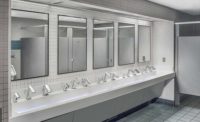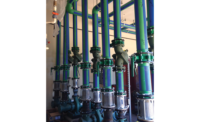“Bếp” in Vietnamese means “kitchen,” which made it the perfect word for Adam Gilpatrick and his wife to use when naming their first restaurant, Bếp Vietnamese Kitchen, in downtown Holly Springs, North Carolina, a suburb of the state’s bustling capital of Raleigh. The locally-owned restaurant offers a lively dining atmosphere serving authentic Vietnamese Street Delights, including familiar Phở selections, Bánh Mì, a variety of snacks and an enormous selection of Boba Tea.
“Food has always been a way of life for our family — bringing us together to share meals and enjoy each other’s company,” Gilpatrick says. “I married into a Vietnamese family, and my mother-in-law often cooks big family-style meals, so Friday at my house may consist of 15 to 20 family members. It’s an open, informal, warm and welcoming atmosphere, and we wanted to bring a lot of what’s at home — the familial feeling, comfort and the food — to the restaurant.”
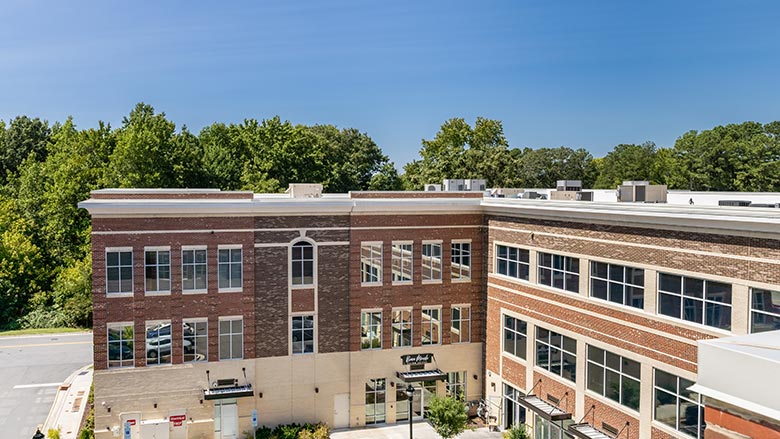 The seamless ability to integrate the LG Split Compact DOAS and LG Multi V 5 VRF products was a key benefit for Adam Gilpatrick, owner of Bếp Vietnamese Kitchen.
The seamless ability to integrate the LG Split Compact DOAS and LG Multi V 5 VRF products was a key benefit for Adam Gilpatrick, owner of Bếp Vietnamese Kitchen.
Project highlights
Bếp Vietnamese Kitchen is on the first floor of The Block on Main, a four-story mixed-use building featuring state-of-the-art offices and workspaces, retail and dining. The 2,880-square-foot restaurant has a vibrant, modern aesthetic with an exposed ceiling and large windows, giving off a stylish and welcoming vibe.
In addition to providing patrons with comforting food, Gilpatrick wanted to ensure that staff and guests alike could work and dine in a well-conditioned space. So, he engaged Durham-based Sunderland Engineering and its founder Gary Sunderland to help design a mechanical system that would provide the HVAC capabilities needed for a busy restaurant.
Sunderland connected with Jackson Willis, director of Engineered Products at Raleigh-based Faulkner Haynes, to assist with the HVAC system design and source products that would meet the project’s comfort, ventilation and energy efficiency needs and fit in with the overall aesthetic of the restaurant. The team devised a system consisting of LG’s Split Compact DOAS (Dedicated Outdoor Air System) and Variable Refrigerant Flow (VRF) technologies and integrated controls for a comprehensive solution.
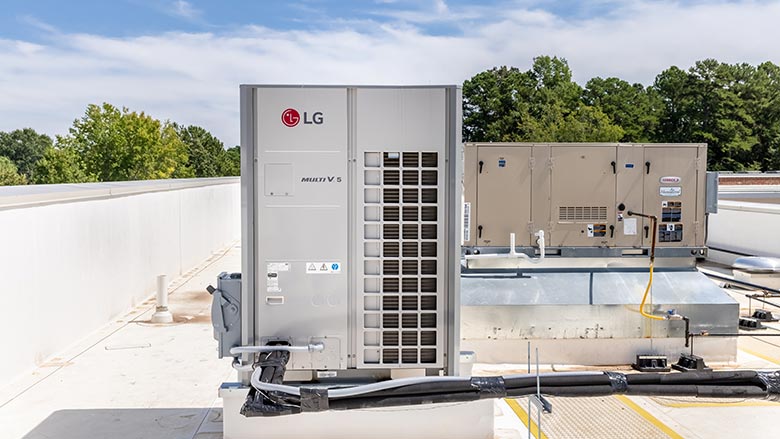 Because of shared roof space of the building, the restaurant was limited on how much of the area it could utilize. LG’s Split Rooftop DOAS units provide 100% outdoor air in heating, cooling and dehumidification modes. Working with LG Multi V VRF equipment, the LG Split Rooftop DOAS unit complements the LG VRF well and conditions fresh outdoor air indoors, without sacrificing energy efficiency.
Because of shared roof space of the building, the restaurant was limited on how much of the area it could utilize. LG’s Split Rooftop DOAS units provide 100% outdoor air in heating, cooling and dehumidification modes. Working with LG Multi V VRF equipment, the LG Split Rooftop DOAS unit complements the LG VRF well and conditions fresh outdoor air indoors, without sacrificing energy efficiency.
Challenges
Properly heating, cooling and ventilating a restaurant is critical to ensuring the comfort of the staff and patrons and providing them with good indoor air quality.
“A restaurant where it’s hot and stuffy is a miserable experience, and I wanted to do whatever I needed to ensure we didn’t have that situation, especially as the key specialty item on our menu is hot soup, and the needs in the kitchen are very different from our dining room, so I needed to have an HVAC solution that can tackle diverse loads,” says Gilpatrick.
In addition to requiring an HVAC system that delivered a comfortable and well-ventilated indoor environment, the team needed a versatile solution that would not necessitate traditional ductwork, given the restaurant’s footprint and desire for exposed ceilings. Because the restaurant is in a mixed-use building, each tenant has a specific amount of square footage available on the roof for HVAC systems.
Structural roof limitations prevented using a packaged rooftop unit, which favors the utilization of the LG Split Compact DOAS. With limited rooftop and restaurant space, the HVAC system needed a small footprint and flexibility in placement to address design needs while still achieving desired performance.
“The piping length for the HVAC system was an additional challenge,” Willis says. “Because the restaurant is on the building’s first floor and the outdoor units are on the roof, we had to get the piping down from the roof and into the space without making too many modifications to the indoor or outdoor units.”
Finally, restaurants carry a lot of overhead costs, so it was essential to have energy-efficient HVAC products to avoid any surprises or increases in the electricity bill. The restaurant also needed a product to manage multiple setpoints in several different areas due to the varying occupancy throughout the entire property.
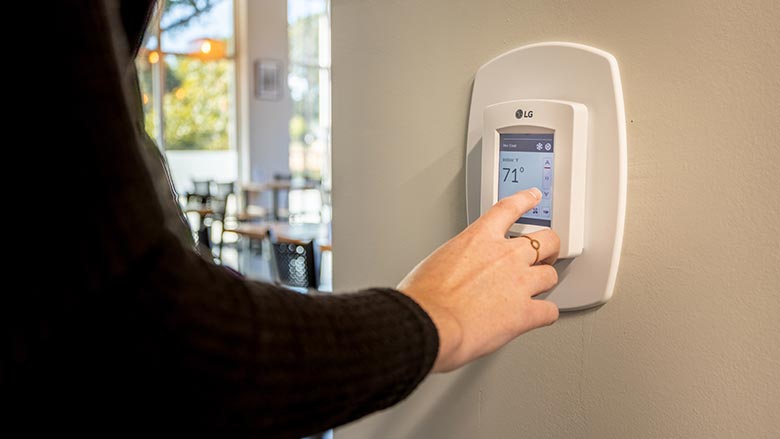 LG's MultiSITE Remote Controller allows customers to tailor the functions and appearance to meet the needs of their application.
LG's MultiSITE Remote Controller allows customers to tailor the functions and appearance to meet the needs of their application.
The solution
After carefully evaluating the criteria, Sunderland and Willis designed a flexible and efficient solution that would address the requirements of the restaurant, tackle challenges and offer enhanced occupant comfort.
The seamless ability to integrate the LG Split Compact DOAS and LG Multi V 5 VRF products was a key benefit for Gilpatrick. The Split Compact DOAS is equipped with a factory-embedded Heat Recovery Unit, which reduces installation time. This built-in feature eliminates the need for a separately purchased Heat Recovery Unit to incorporate Hot-Gas Reheat for high sensible load and hot weather applications. What’s more, LG’s Split Rooftop DOAS units provide 100% outdoor air in heating, cooling, and dehumidification modes. Working with LG Multi V VRF equipment, the LG Split Rooftop DOAS unit complements the LG VRF well and conditions fresh outdoor air indoors, without sacrificing energy efficiency.
“Because of the shared roof space, we were limited in how much of the area we could utilize,” Sunderland says. “One of the advantages of the Split Rooftop DOAS and VRF system is the link between indoor and outdoor components. And the ability to select system sizes that met aesthetic needs and piping lengths was critical. The products we specified for this project fit the owner’s needs in terms of placement flexibility and equipment size.”
The team used LG’s Mid-Static Ducted M3 Chassis for air handling to address the restaurant’s high, exposed ceiling. The Mid-Static Ducted M3 Chassis are installed in the ceiling and operate quietly, which is vital in a restaurant setting. In addition, the LG Split Compact DOAS eliminated the need for extensive ductwork running throughout the space. Conventional HVAC systems with mixed air require ductwork to return to the rooftop unit. By decoupling the ventilation load utilizing LG’s Compact DOAS, the restaurant was able to eliminate return air ductwork back to the unit. Additionally, with the indoor units and the Split Compact DOAS the restaurant was able to distribute air evenly and by zone, resulting in a much shorter supply and return ducting per indoor unit.
Keeping electricity costs down was paramount to Gilpatrick. “I was a bit worried my electricity bill was going to be high, but this is not your 1980s HVAC system. It is very efficient,” he notes.
The LG integrated controls also helped Gilpatrick address the restaurant’s electricity costs. The LG AC Smart 5 control solution allows owners to access the units and incorporate the interlock function — a utility that increases energy-saving opportunities by providing more control and visibility into equipment settings, like indoor and outdoor temperature/humidity and operating status.
Gilpatrick also liked the MERV 8 filters included as standard with LG’s Split Compact DOAS as they help filter particulates and provide the ability to upgrade to 2-inch MERV 13 filters if or when needed.
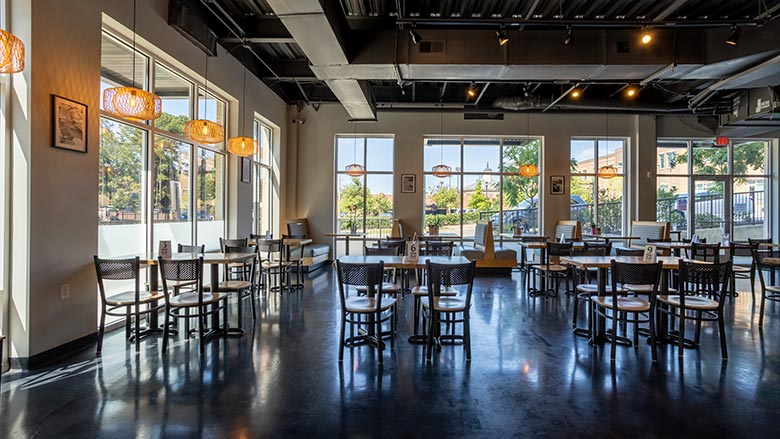 The design team used LG’s Mid-Static Ducted M3 Chassis for air handling to address the restaurant’s high, exposed ceiling. The Mid-Static Ducted M3 Chassis are installed in the ceiling and operate quietly, which is vital in a restaurant setting.
The design team used LG’s Mid-Static Ducted M3 Chassis for air handling to address the restaurant’s high, exposed ceiling. The Mid-Static Ducted M3 Chassis are installed in the ceiling and operate quietly, which is vital in a restaurant setting.
The result
In selecting and installing the LG DOAS and Multi V VRF system, Gilpatrick was able to get a total building solution that is flexible, energy-efficient, brings outdoor air into the building, and does not rely on natural gas heating or electric resistance heat.
“Since opening, we have had a consistent stream of business,” Gilpatrick says. “The reviews for the food and the space itself have been overwhelmingly positive. The LG systems have kept the restaurant comfortable and helped with ventilation and indoor air quality, which has allowed us to focus on the business and our customers rather than worry about the HVAC.”

